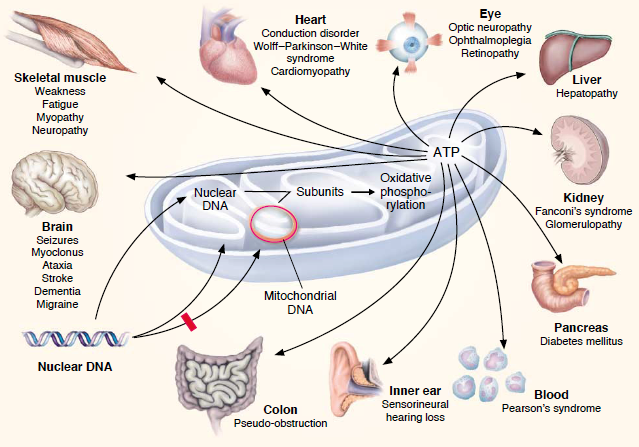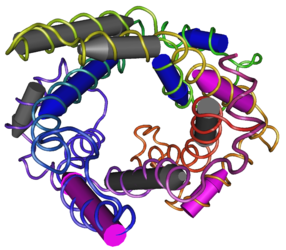Uncoupling Protein 2
From Proteopedia
(Difference between revisions)
| Line 7: | Line 7: | ||
== History == | == History == | ||
| - | In 1963, researchers discovered that mitochondria have their own DNA or "blueprint" (mtDNA), which is different than the nuclear DNA (nDNA) found in the cells' nucleus. <ref>Mitochondrial Disorder Medical Information. http://www.mitoaction.org/medical-information.</ref> Later, in 1988, mutations of this mitochondria DNA was discovered. Mutations like deletions and point mutations were found in all the mitochondrial disorders.<ref>Luft, R.; Luthman, H. Physiopathology of mitochondria. From Luft's disease to aging and diabetes. https://www.ncbi.nlm.nih.gov/pubmed/8366714.</ref> | + | In 1963, researchers discovered that mitochondria have their own DNA or "blueprint" (mtDNA), which is different than the nuclear DNA (nDNA) found in the cells' nucleus. <ref>Mitochondrial Disorder Medical Information. http://www.mitoaction.org/medical-information.</ref> Later, in 1988, mutations of this mitochondria DNA was discovered. Mutations like deletions and point mutations were found in all the mitochondrial disorders.<ref>Luft, R.; Luthman, H. Physiopathology of mitochondria. From Luft's disease to aging and diabetes. https://www.ncbi.nlm.nih.gov/pubmed/8366714.</ref> The discovery of five UCPs are of great importance to the study of the mitochondria. A sequence relating to UCP1 lead to the ultimate discovery of UCP2 in 1997. <ref>Sreedhar, A.; Zhao, Y. Uncoupling protein 2 and metabolic diseases. https://www.ncbi.nlm.nih.gov/pmc/articles/PMC5477468/</ref> |
== Disease == | == Disease == | ||
| Line 31: | Line 31: | ||
Figure 2: Uncoupling Protein 2 | Figure 2: Uncoupling Protein 2 | ||
| - | This is a sample scene created with SAT to <scene name="/12/3456/Sample/1">color</scene> by Group, and another to make <scene name="/12/3456/Sample/2">a transparent representation</scene> of the protein. You can make your own scenes on SAT starting from scratch or loading and editing one of these sample scenes. | ||
</StructureSection> | </StructureSection> | ||
== References == | == References == | ||
<references/> | <references/> | ||
Revision as of 03:33, 15 April 2019
Uncoupling Protein 2 (UCP2) in Diabetes
| |||||||||||
References
- ↑ Mitochondrial Disorder Medical Information. http://www.mitoaction.org/medical-information.
- ↑ Luft, R.; Luthman, H. Physiopathology of mitochondria. From Luft's disease to aging and diabetes. https://www.ncbi.nlm.nih.gov/pubmed/8366714.
- ↑ Sreedhar, A.; Zhao, Y. Uncoupling protein 2 and metabolic diseases. https://www.ncbi.nlm.nih.gov/pmc/articles/PMC5477468/
- ↑ Maassen, J. A.; Leen; Hart; Essen, E. van; Heine, R. J.; Nijpels, G.; Tafrechi, R. S. J.; Raap, A. K.; Janssen, G. M. C.; Lemkes, H. H. P. J. Mitochondrial Diabetes. http://diabetes.diabetesjournals.org/content/53/suppl_1/S103.
- ↑ Sivitz, W. I.; Yorek, M. A. Mitochondrial dysfunction in diabetes: from molecular mechanisms to functional significance and therapeutic opportunities. https://www.ncbi.nlm.nih.gov/pmc/articles/PMC2824521/.
- ↑ Chan, C. B.; Saleh, M. C.; Koshkin, V.; Wheeler, M. B. Uncoupling Protein 2 and Islet Function. http://diabetes.diabetesjournals.org/content/53/suppl_1/S136.
- ↑ Sophie Rousset, M.-C. A.-G.; Mozo, J.; Bruno Miroux, A.-M. C.-D.; Bouillaud, F.; Ricquier, D. The Biology of Mitochondrial Uncoupling Proteins. http://diabetes.diabetesjournals.org/content/53/suppl_1/S130.


